In 1984, the Wallabies came to Europe and left with a glorious Grand Slam that will live long in the memory. Fast forward 22 years and can they repeat it?
It was 1984. Australia were led into battle by the rugby equivalent of Donald Trump, a political speech-writer (and future radio chat-show host) named Alan Jones.
With only one season of club coaching behind him, Jones used his experience as a successful businessman to get the job done. If he didn’t know how to do something himself, he quickly found people who did – like forwards coach and future Welsh rugby coach Alex Evans, or England scrum guru Phil Keith-Roach.
The results were spectacular. Australia won their first touring ‘grand slam’ of the home unions, completing a clean sweep of England, Ireland, Wales and Scotland – and by an average margin of 22 points per game. They even scored a pushover try against Wales at the Arms Park, such was their domination.
Several Wallaby greats cemented their place in rugby history on that tour – Roger Gould, David Campese, Michael Lynagh, Mark Ella and Nick Farr-Jones in the backs; ‘Topo’ Rodriguez, Tommy Lawton, Steve Cutler and Simon Poidevin up front.

In full flow: Roger Gould, David Campese and Andrew Slack in action at the Arms Park
The end-of-year tour in 2016 represents the first opportunity the Wallabies have had in 32 years to repeat that performance. Having finished second in the recent Rugby Championship behind New Zealand, and ranked third in the world on the latest IRB world rankings, at first glance they look in a good position to achieve their aim.
They have another successful businessmen at the coaching helm in the shape of Michael Cheika. Fluent in four languages, Cheika built his business empire in the global fashion industry and sees a ready comparison between business and sports coaching:
” It’s something I’ve learnt more and more as I’ve gone on in coaching and business… the truth that people drive everything. And the best that you can get out of each person at their own level, the more you’re going to get. The more they’re going to enjoy it as well and hopefully you’re going to get the right results at the end.”
So what people will Cheika bring with him to the UK in November, and do they have enough quality to emulate their forebears and win another Grand Slam?
On the coaching front, Cheika has Stephen Larkham, a Wallaby legend from the World Cup-winning era of Rod Macqueen (another businessman who modelled himself as the “CEO” of a board of playing and coaching “delegates”) around the turn of the millennium. Larkham has recently gone full-time and is being groomed to replace Cheika in much the same way as Steve Hansen was anointed as successor to Graham Henry in New Zealand.

Star turn: MIchael Hooper is explosive at the back of the scrum
On the playing front, the Wallabies recovered from heavy beatings in the first two rounds of the Rugby Championship against the All Blacks to win three of their last four games against South Africa and Argentina.
Up front, they boasted probably the strongest scrummaging front row in the tournament under the tutelage of ex-Argentine hooker Mario Ledesma. Scott Sio, Stephen Moore and Sekope Kepu are unlikely to come off second best against any of the scrums they will meet in the home unions on tour.
The Wallabies have also unearthed a core of very big men in the back five who can all run, jump and tackle: 6’10 120kgs Rory Arnold, 6’8 122kgs Adam Coleman and 6’4 123kgs no.8 Lopeti Timani. Add in the likes of recent John Eales medal winner Michael Hooper and injury returnee David Pocock and you have the makings of a forward unit to be reckoned with.
Unusually for Australia, the problems really begin in the back-line. Their two outstanding backs in the Rugby Championship were scrum-half Will Genia and outside centre Samu Kerevi – but Genia may not be released by his French club Stade Francais for the two crucial matches that fall outside the November window (5 November against Wales at the start and 3 December versus England at the end), while Kerevi has been ruled out of the entirety of the tour by injury.

Little general: Will Genia has reproduced some of his best form but he may not be available for Wales
Elsewhere there is uncertainty. Reece Hodge is versatile but his best position in the backs has yet to be decided, Sefa Naivalu only became eligible for Wallaby selection on September 18, while rugby league convert Marika Koroibete has yet to play a game of professional rugby union.
Much will depend on what I believe to be the first-choice half-back combination of Genia and Quade Cooper. The Waratahs’ pairing of Nick Phipps and Bernard Foley did not really cut the mustard in the third Bledisloe match at Eden Park, which Australia lost 37-10 to New Zealand.
With 136 Wallaby caps between them, Genia and Cooper both have experience of rugby in two hemispheres and understand each other’s game from their shared time at the Reds in the eight years from 2007-2015.
Australia’s best attacking game of the Rugby Championship was against Argentina in Perth, which they won handily 36-20. It was keyed by the outstanding contributions of Genia and Cooper.
- Will Genia (defensive speed, tackling technique, speed endurance). Genia scored two tries in the game and showcased his ability on both sides of the ball. At an early defensive lineout, he flew off the end of the line to break up the pass of Puma #10 Nicolas Sanchez:
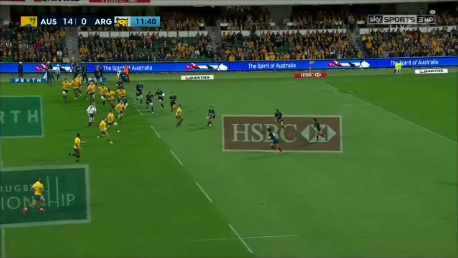
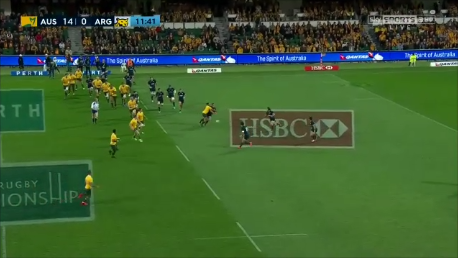
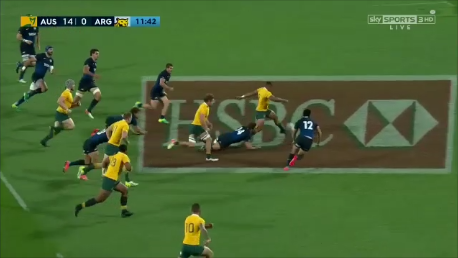
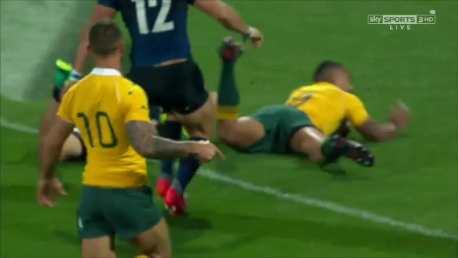
Genia not only dictates the speed of the Australian defensive line, he hits hard but above the level of the ball, so that there is no knock-on when Sanchez goes to make the pass. He also has enough speed endurance to win the chase to the goal-line against the Argentine cover defence.
- Will Genia (decision-making, ball-placement, ‘reloading’’ back on feet).At the attacking lineout at 51:30, Genia shows his ability to improvise decisions ‘on the hoof’. He realizes that the intended back-line move is not on after a loose lineout tap and takes the ball over the advantage line himself. The big pick & go play by Sean McMahon on next phase is enabled by Genia’s quick (one second) ball presentation. Moreover, the scrum-half is already back on his feet and ready to service the next breakdown, finally burrowing through a small hole underneath the Argentine prop forward Tetaz Chaparro to score his second try.
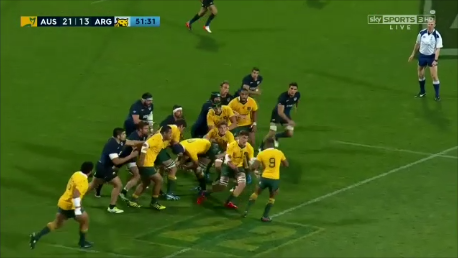
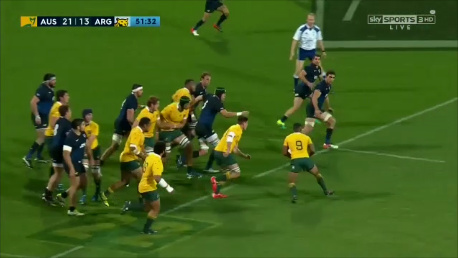
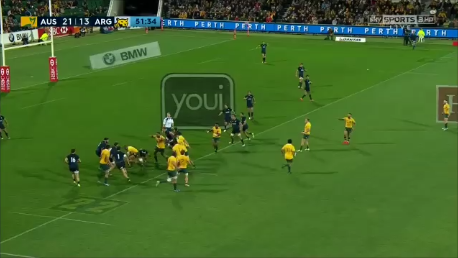

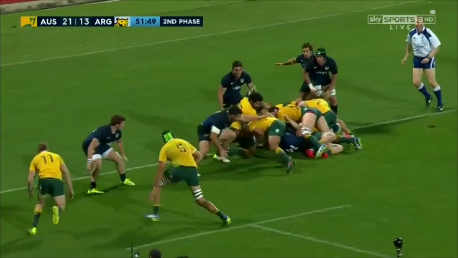
- Will Genia (decision-making, challenging the first defender). Genia also has a significant part to play in Australia’s fifth try by Michael Hooper:
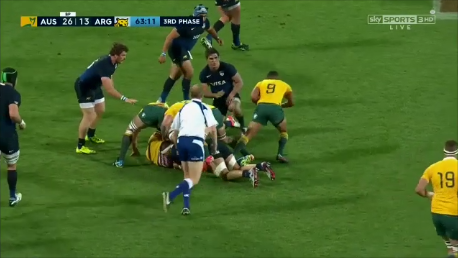
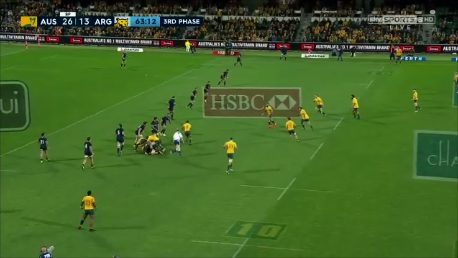
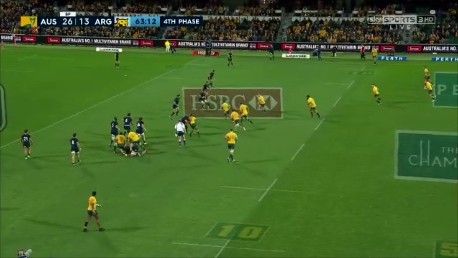
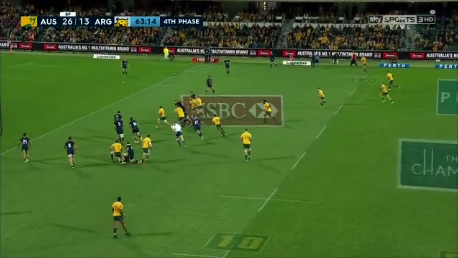
Genia sees that there is a promising attacking set-up with three Australian forwards in position to run angles off Quade Cooper, but in order to exploit it Genia has to break up the Puma defensive front by attracting the first defender (one out from the ruck), Juan Manuel Leguizamon in the two-tone head-guard. Genia takes three lateral steps to his right to pull Leguizamon on to him before releasing the pass to Cooper only when the tackle is fully committed. This in turn enables Cooper to deliver an in-pass to Hooper in the hole where Leguizamon would have been. This ability to challenge the first defender is matched probably only by Ben Youngs of England among the #9’s currently playing international rugby.
- Quade Cooper (playing flat, inside pass, misdirection). Cooper’s part in the 64th minute try is the other aspect of the play worthy of comment. When he receives the ball, Cooper is playing flat on the advantage-line (level with the hindmost foot of the ruck). If there is a hole for Hooper to exploit, he will be through it immediately. Cooper is square to the tackler with the ball held in two hands, which means that he is a threat to run or pass either to the inside or the outside. The real finesse is in Cooper’s ‘eyes’, which pull the defender (Ramiro Herrera) outside and away from the hole Cooper intends to target.
- Quade Cooper (playing flat, inside pass, misdirection). Cooper’s attacking qualities at first receiver were in evidence even more clearly in the first phase try from lineout scored in the 8th minute:
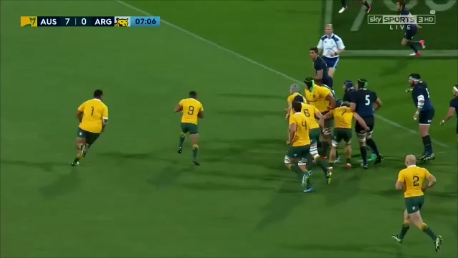
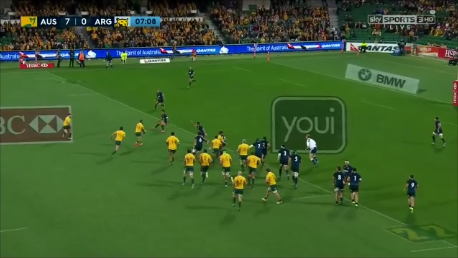
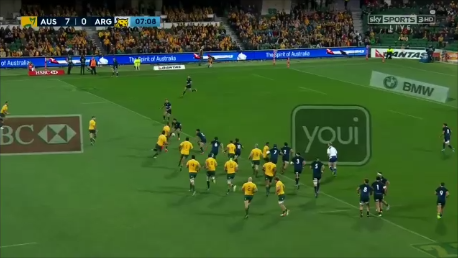
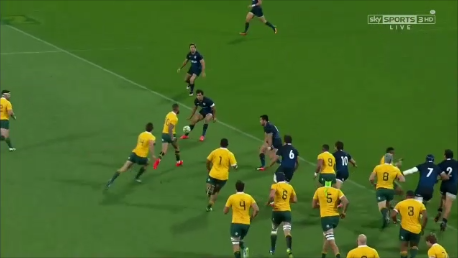
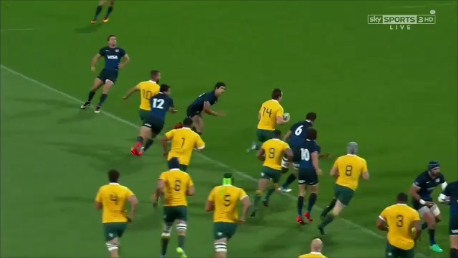
The ball is peeled off the back of the lineout by David Pocock and Genia initially, with Cooper again delivering the inside pass right on the advantage-line. Cooper is so square to the two defenders in the area (the Pumas #12 and #13) that his ‘eyes’ pull both of them on to the ball, and away from the hole targeted by wing Dane Haylett-Petty. I do not believe any 10 in the world delivers this ‘no-look’ in-pass with the same degree of subtlety and deception as Quade Cooper.
- Quade Cooper (playing off the line, communication, decision-making). The final sequence, from Australia’s first try in the very first minute, illustrates Cooper’s ability to vary his position according to the intended area of attack.


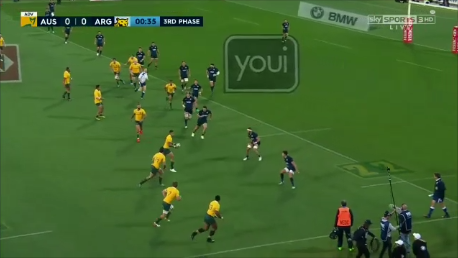
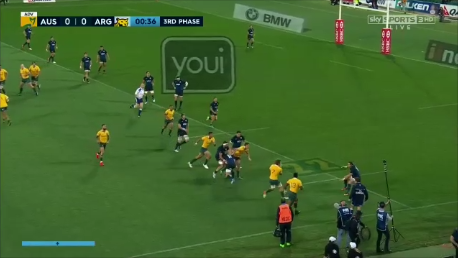
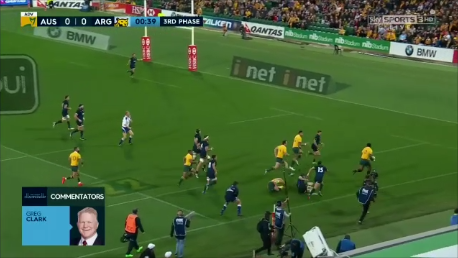
As the midfield ruck begins to set, Cooper turns out to the attacker outside him (Israel Folau) to communicate the play. Because Australia have a very solid 3-on-2 overlap out to the right hand touch, Cooper drops half-a-dozen steps off the line in order to give time and space for the ball to reach the Wallaby numbers in the wide channels. A simple left-handed pass is enough to bring the overlap to fruition, with accurate decisions made by everyone in the space outside (Folau, Haylett-Petty and Hooper).
Summary If Australia are able to select the pairing of Genia and Cooper throughout the Autumn series, I believe they have the ability to win at least four of their five Tests. If Genia is unavailable and Cooper is not selected, there is a real danger of the Wallabies returning back home with more losses than wins in the ledger, and 1984 dimmer in the memory.
Watch all of England’s autumn internationals as well as Ireland vs New Zealand live on Sky Sports this November






